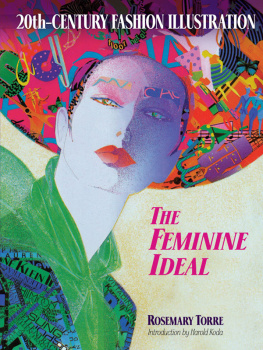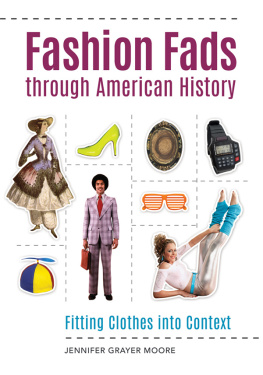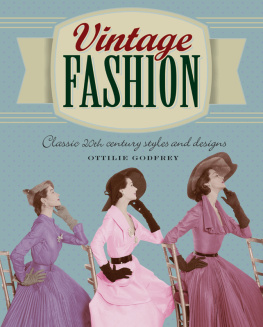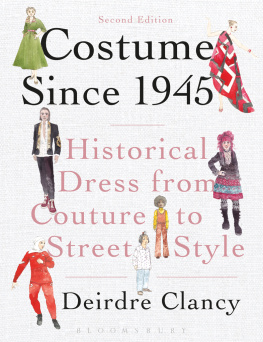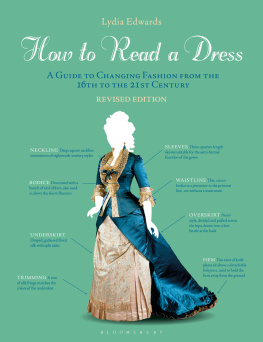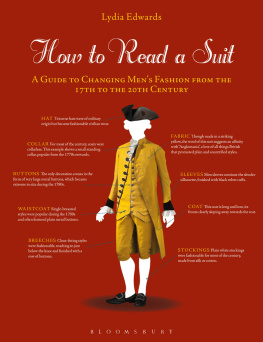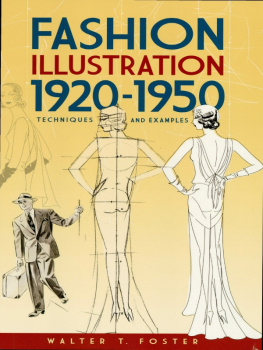20th-Century Fashion Illustration
The Feminine Ideal

20th-Century Fashion Illustration
The Feminine Ideal
Rosemary Torre
With an Introduction by Harold Koda
Dover Publications, Inc.
Mineola, New York
Copyright
Copyright 2011 by Rosemary Torre
All rights reserved.
Bibliographical Note
20th-Century Fashion Illustration: The Feminine Ideal is a new work,
first published by Dover Publications, Inc., New York, in 2011.
International Standard Book Number
ISBN-13: 978-0-486-46963-8
ISBN-10: 0-486-46963-8
Manufactured in the United States by Courier Corporation
46963801
www.doverpublications.com
In memory of Sally Wecksler
F ashion illustration as we know it was born in the first decade of the 20th century. In the past, fashion plates had been ethnographic depictions of regional dress, descriptions of fantasy costumes, or meticulous engravings of la mode to be copied by seamstresses. Paul Poiret, the exalted French couturier, asked for something entirely new to depict and publicize his creations. He chose two comparative newcomers, Paul Iribe and Georges Lepape, to illustrate his promotional albums of 1908 and 1910. They created unique and exquisite drawings, which caught the eye and captured the imagination of the fashionable elite. The figures inhabited a rarified world of elegance and poetry. They were imaginative interpretations rather than literal representations, as brilliantly colored as exotic birds. Their creators, young artists trained at the Ecole des Beaux Arts, had taken the first step toward modern fashion illustration.
The graphic representation of garments in order to promote and sell them became a highly specialized field, reaching a peak in the early 1940s and 1950s when the work of artists like Carl Erickson, Ren Bout-Williaumez, and Ren Bouch graced the pages of numerous American and foreign publications. Vogue and Harpers Bazaar in America and Femina, LOfficiel and Plaire in France were glossy showcases of superb fashion illustrations. Photography eventually replaced artwork, although fashion illustrations continued to be used well into the 1990s, particularly in French and Italian publications. But never again has fashion art enjoyed the prominence in magazines and newspapers that it enjoyed in its heyday.
Leading fashion illustrators possessed a unique talenta flair, a light touchand the ability to idealize subject matter. In order to satisfy the promotional and commercial aspects of the industry, garments had to look better than they did in actuality and the figures wearing them had to be models of perfection. Fashionable women were expected to identify with an alluring graphic image, propelling them to the salon or the emporium that promised to realize that image. The illustrations, therefore, must be highly attractive, chic and, above all, expressive of modern life. Fashion is, after all, of the moment, often of the future; even when in a retro style, fashions and fashion illustrations are up-to-date. In order to create the quintessential female, the successful illustrator possessed an instinctive understanding of the culture and high life of the period, and the ability to express the unspoken desires of the viewer. Presented with an Ideal, fashionable women would strive to live up to it.
The Ideal, an intangible, is formed in the imagination by a variety of social, political, economic, esthetic, and subjective forces.
This is no less true of its personification, whether Miss Liberty, majestic in New York Harbor, or a drawing of a beautiful woman in a Dior cocktail dress. The Ideal is not a matter of personal preference, but rather an expression of her time. She is invariably the new womanan original, irresistible force. She points to the future and ultimately is seen as the embodiment of her era. She is universal, never outlandish or inscrutable, only enviable.
20th-Century Fashion Illustration: The Feminine Ideal attempts to show how fashion illustrators portrayed the Ideal from 1900 to 2000. Through the choice of materials and techniques, and sensing what was in the air, the artist depicted the very essence of modern femininity and societys perception of the new woman, adding a highly individual response to the task at hand, and continually modifying both his vision and his method of achieving it in order to be considered relevant. To accurately depict the Ideal and to invest her with modernity, he must be keenly aware of her current manifestation and possess an essential understanding of contemporary life. Just as her clothes and hairstyles change in his drawings, so do her proportions, her stance, and her facial expressions. The text points to some of the external forces that shaped the Feminine Ideal of the time. In a sense, the fashion illustrator is an important contributor, giving her form and a persona. It is the fashion illustrator who uses his receptivity and talent to recognize and delineate her, from Art Deco siren to contemporary athletic goddess. If we want to see her for ourselves, all we need do is look at the pictures.
Once considered ephemera and categorized as advertising art, high caliber fashion illustration has become the focus of many personal and institutional collections. The Frances Neady Collection of Original Fashion Illustrations at The Fashion Institute of Technology (FIT) in New York City, for example, owns more than 300 vintage and contemporary high-fashion drawings, offering a broad view of the field. The Society of Illustrators, established in 1901, continues to offer outstanding exhibitions of fashion art. The Stubs Gallery, the FAD (Fashion and Design) Gallery, and the Leslie/Lohman Day Art Foundation have mounted excellent exhibitions of fashion illustrations. Joelle Chariau, of the internationally renowned Galerie Bartsch and Chariau in Munich, owns a premiere collection of fashion illustrations. The Jean S. and Frederic A. Sharf collection of fashion art has found a permanent home in the Museum of Fine Arts in Boston; and Illustration House in Chelsea, New York, has seen an increase in the sale of fashion art to enthusiastic collectors.
High-quality fashion illustration has a strong affinity to the fine arts, and can be appreciated for similar virtuesinvention, superb draftsmanship, design, and technical skill. It is more than the illustration of clothing. 20th-century Fashion Illustration: The Feminine Ideal presents it as a record of womens progress toward personal fulfillment; as an authentic artistic expression; and as a vivid interpretation of the feminine mystique.
Rosemary Torre
R osemary Torre was among the first faculty members at the Fashion Institute of Technology that I met as a curator of costumes at the Edward C. Design Laboratory, for the simple reason that she was the rare instructor who took advantage of every opportunity for her classes to work directly from the extraordinary designs in the museums archives. In her tenure as professor of illustration at FIT, she was a mentor to generations of fashion illustrators, espousing a simple philosophy: life informs art, and art at its best transforms life.
Her establishment of the Frances Neady Collection of Original Fashion Illustrations housed in Special Collections at FIT was in part an endorsement of the importance of the primary practitioners of her field to the history of fashion, and includes, notably, examples from many of her students. But the collection is also an expression of her conviction that through this body of images a fuller understanding of culture and society is gleaned. This book, therefore, merges Torres knowledge of the history of fashion illustration with her belief in its transformational role in the mutable identities of women in 20th-century and contemporary life.
Next page
